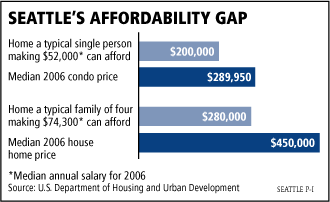Come to the Rowhouse/Townhouse Forum to Support Affordable Housing in Seattle
There are a number of features in the current version of the multi-family update that will improve our multi-family housing. They will produce housing with better street frontage, more useful open space, improved public process, and of overall higher design quality. It is a good start & I support it wholeheartedly. But today’s version of the legislation doesn’t go far enough.
The Problem
The biggest “missing piece” is that our current code is structured in a manner that has a decidedly adverse impact on housing affordability. There are a couple of simple changes that are up for discussion that would significantly improve affordability if they are implemented. But they are also considered “third-rail” issues, & I am concerned that the council will not take them on unless they hear strong support for them in the community (not just the architects and urban planners).
Density Limits:
Currently, Seattle has strict density limits in place in all of the L-zones. These limits essentially dictate the minimum size of housing unit in a given zone. As a result the average Townhouse in Central Seattle is about 1500sf in size and sells for around $450,000. Density limits were created in an era when a single family home was affordable for people with median income & the most pressing concern of the body politic was fighting density. Today, density is no longer a dirty word, but we live in a city where ownership housing is increasingly out of reach for Seattle’s workforce.
The city council is considering removing density limits in the L-zones. The result of this will not be little cracker-box units sprouting up all over Seattle. There are still a number of factors: Parking requirements, design review thresholds, platting requirements for fee-simple ownership, condominium liability – that have a tendency to push L-zone development towards fewer numbers of larger units. The most likely outcome is that unit size and prices would be reduced around 25-35% from what we see today. It’s a minor uptick in density but a huge change in affordability – pushing down townhouse prices where they are within reach for a family with median income.
Parking Requirements:
Parking requirements also act as a form of density limit. Current code requires one off-street parking space for each unit. While this might be a sensible requirement for some neighborhoods and some kinds of development, for many of our denser urban neighborhoods, this prevents us from doing the kinds of development that best serves our housing needs. The council is currently studying the idea of reducing or eliminating parking requirements in Urban Centers and Urban Villages – our densest and best transit served neighborhoods (see map) Doing so won’t unleash a flood of reduced parking development. Developers will continue to build as much parking as they think they need to serve their building and for a bank to finance it.
What reduced the parking requirements will allow is for small innovations to take place: An old home might be split into three flats without turning the yard into a parking lot, or a conventional townhouse project might include a unit or two with small apartments instead of three story townhomes. There is lots of friction is the system that will tend to hold us to our old way of doing things, but easing up on these requirements will allow innovation to begin & allow new development that produces smaller, more affordable, and less auto-centric housing.
Conclusion:
Our current code hails from 1989. It was written from the point-of-view that no good could come of density and development. It was an attempt to pull up the gangplank & prevent growth pressure from changing the character of our neighborhoods. Ironically, the code did nothing to stop growth, but it did help to make manifest the dystopian vision of what growth would bring. It consigned Seattle to third-rate housing solutions and flooded our neighborhoods with a drove of poorly designed, unaffordable, ill-conceived housing stock.
A generation later we have very different concerns. As a city we have finally invested in mass-transit infrastructure, and committed ourselves to the goal of making density work. We live in one of the most desirable cities in the world, one that will continue to be a magnet for in-migration for the foreseeable future We want to preserve the character of our single family neighborhoods, but not at the expense of the other half of our city’s residents. We want to build quality, affordable, green multi-family neighborhoods as well.
Please come to the meeting, lend your support & help make this happen.
Rowhouses, Apartments & Townhomes – A Special Community Meeting – Saturday 3/20, 10 am – Taproot Theatre in Greenwood (204 N 85th St)

